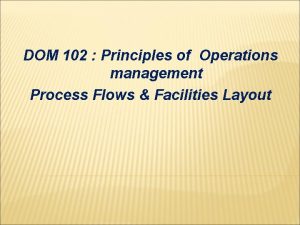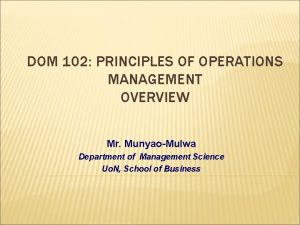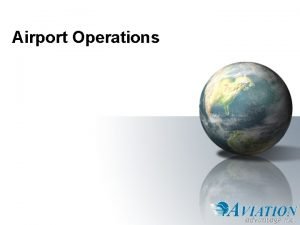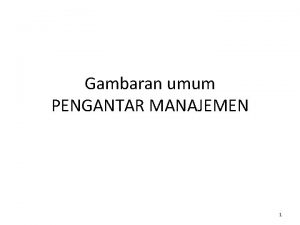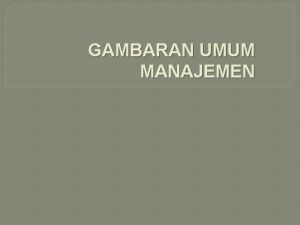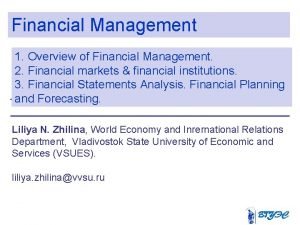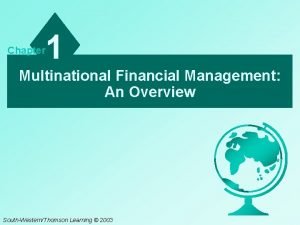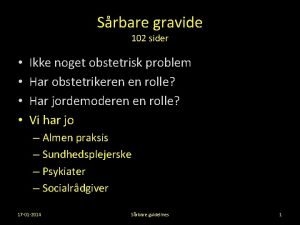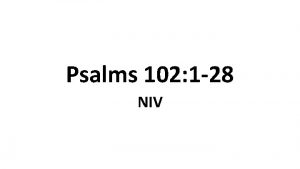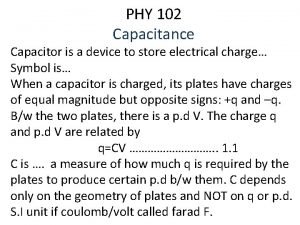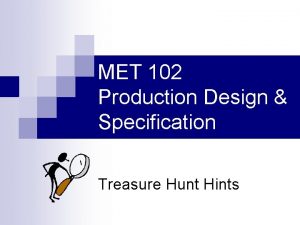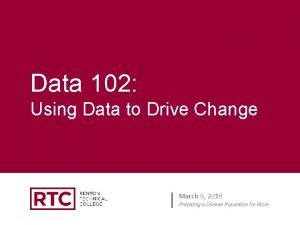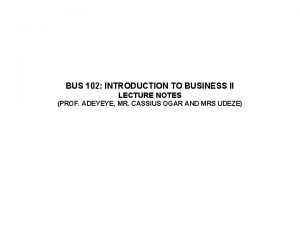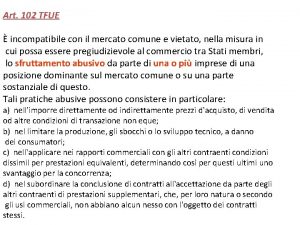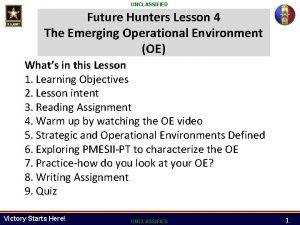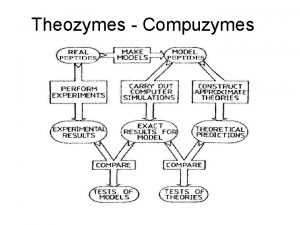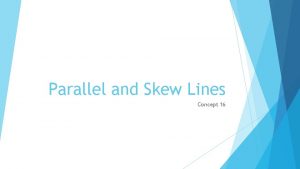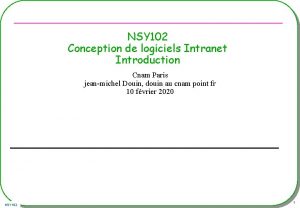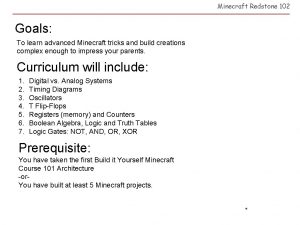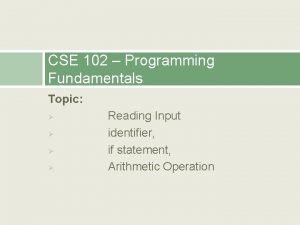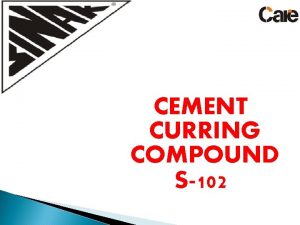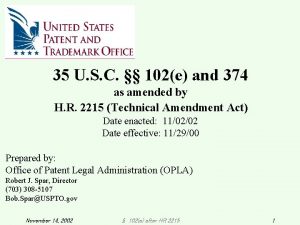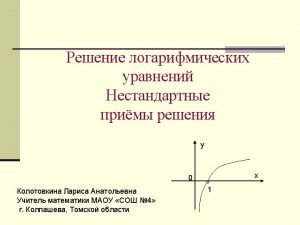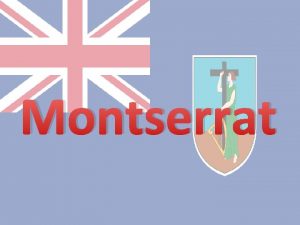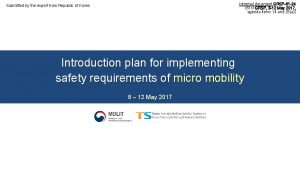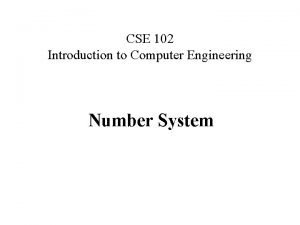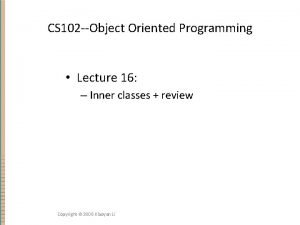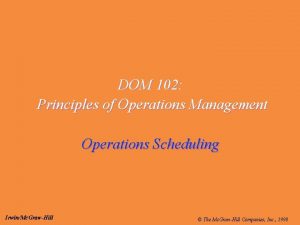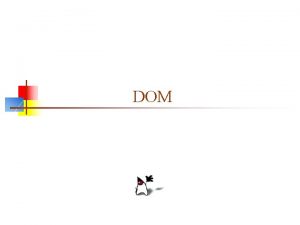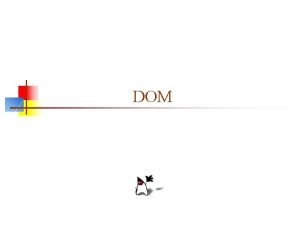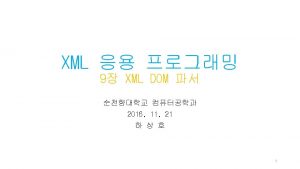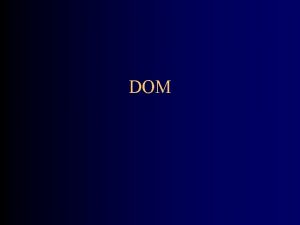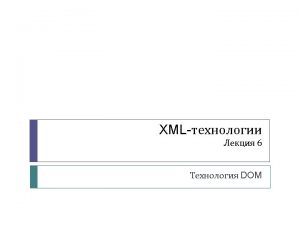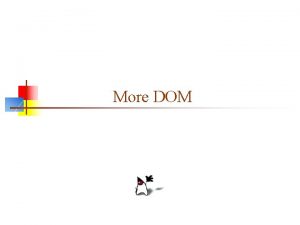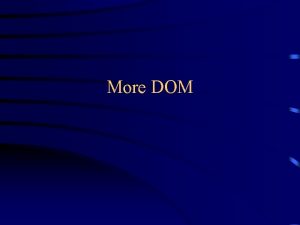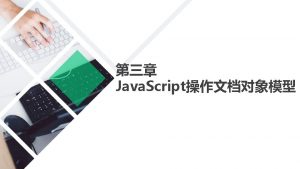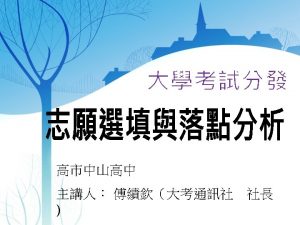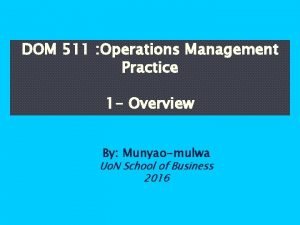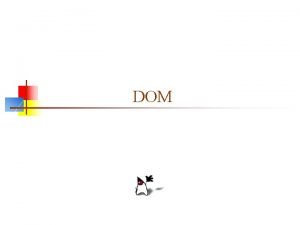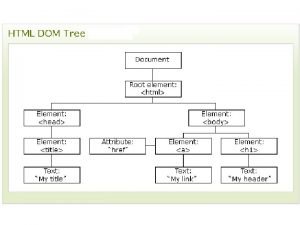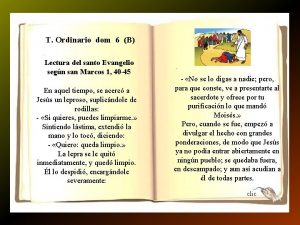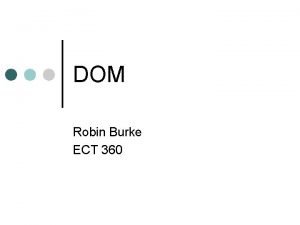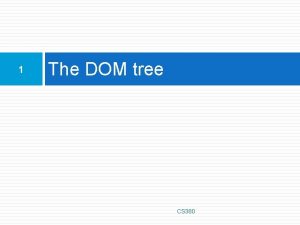DOM 102 PRINCIPLES OF OPERATIONS MANAGEMENT OVERVIEW Mr





























































- Slides: 61

DOM 102: PRINCIPLES OF OPERATIONS MANAGEMENT OVERVIEW Mr. Munyao-Mulwa Department of Management Science Uo. N, School of Business

1: INTRODUCTION TO THE FIELD OF OM In managing any business, gaining competitive advantage is of prime importance. CA is achieved by excelling in meeting needs of specific customer segment irrespective of discipline i. e finance, marketing etc Serving customer well means in a timely fashion, with exceptional quality & at lowest cost possible (efficient) Organizations need to design & operate processes that are quick, accurate & inexpensive 2

INTRODUCTION TO THE FIELD OF OM To deliver value to customers, organizations should craft efficient & effective operations Value = Quality/Price (People, processes & technology integrate to create value) How can one increase value to customers? 2

OPERATIONS IN AN ORGANIZATION The operations function is central to the organization because it produces the goods and services which are its reason for existing, but it is neither the only nor necessarily the most important fn It is, however, one of the three core functions of any organization; the marketing (including sales) function – which is responsible for communicating the organization’s products and services to its markets in order to generate customer requests for service 2

OPERATIONS IN AN ORGANIZATION The product/service development function – which is responsible for creating new and modified products and services in order to generate future customer requests for service The operations function – which is responsible for fulfilling customer requests for service throughout the production and delivery of products and services. In addition, there are the support functions which enable the core functions to operate effectively. Give examples. . 2

WHY STUDY OPERATIONS MANAGEMENT? Systematic Approach to Org. Processes ( Analytical thinking) Business Education ( Students need exposure) Operations Management Career Opportunities Cross-Functional Applications 3

OPERATIONS MANAGEMENT DEFINITION §Operations management may be defined as the design, operation, and improvement of the production system that creates the firm’s primary products and services. §It is the science & art of ensuring that goods & services are created & delivered successfully to customers. 4

ACTIVITIES OF OM DISCIPLINE Layout planning to give smooth and effective flow of customers (Process design) Designing stylish products that can be packed efficiently (Product design) Making sure that all staff can contribute to the company’s success (Job design) Locating stores of an appropriate size in the most effective place (Supply network design) Arranging for the delivery of products to stores (Supply chain management) Coping with fluctuations in demand (Capacity management) Maintaining cleanliness and safety of storage/work areas ( Failure prevention) Avoiding running out of products for sale (Inventory management) Monitoring and enhancing quality of service to customers (Quality management) Continually examining and improving operations practice (Operations improvement) 4

IN SUMMARY §Understanding the needs of customers, measuring customer satisfaction & using information to develop new & improved goods & services §Using information about customers, goods and services, operations, employees etc to make better decisions. §Exploiting technology to design goods, services, manufacturing & service delivery processes that respond to customer requirements & improve productivity 4

OPERATIONS DECISION MAKING Marketplace Corporate Strategy Finance Strategy Operations Strategy Marketing Strategy Operations Management People Materials & Customers Input Plants Parts Planning and Control Production System Processes Products & Services Output 5

GOODS PRODUCTION VS SERVICES Service Uniqueness Intangible Direct customer involvement Location of service facility Can not be stored for future use 9

OPERATIONS AS A SERVICE Operations whether in manufacturing or in a service organization can be treated as service. The core services customer want; Quality Flexibility Delivery Speed Price (or production cost) 11

OPERATIONS AS A SERVICE… Value-added services These make external or internal customer’s life easier Information – ability to furnish critical data on product performance, process parameters & cost Problem Solving – especially in quality Sales Support – By demonstrating the technology, equipment or production systems the company is trying to sell. Field Support – Ability to replace defective parts quickly 12

HISTORICAL EVENTS IN OM ü ü ü ü Industrial Revolution Scientific Management Human Relations Management Science Quality Revolution Globalization Information Age/Internet Revolution

HISTORICAL EVENTS IN OM Industrial Revolution Steam engine Division of labor Interchangeable parts 1769 1776 1790 James Watt Adam Smith Eli Whitney Scientific Management Principles Time and motion studies Activity scheduling chart Moving assembly line 1911 1912 1913 Frederick W. Taylor Frank & Lillian Gilbreth Henry Gant Henry Ford

HISTORICAL EVENTS IN OM Human Relations Hawthorne studies Motivation theories 1930 1940 s 1950 s 1960 s Elton Mayo Abraham Maslow Frederick Hertzberg Douglas Mc. Gregor Management Science Linear programming Digital computer Simulation, PERT/CPM, Waiting line theory MRP 1947 1951 1950 s 1960 s George Dantzig Remington Rand Operations research groups Joseph Orlicky, IBM

HISTORICAL EVENTS IN OM Quality Revolution JIT Ohno, Toyota TQM 1970 s 1980 s Strategy and operations Reengineering World Trade Organization 1990 s Taiichi W. Edwards Deming, Joseph Juran, et. al. Skinner, Hayes Hammer, Champy Numerous countries and companies Globalization European Union and other trade agreements EDI, EFT, CIM 1970 s 1980 s IBM and others

HISTORICAL EVENTS IN OM Information Age/ Internet Revolution Internet, WWW, ERP Supply chain management, E-commerce 1990 s ARPANET, Tim Berners-Lee, SAP, i 2 Technologies, ORACLE, People. Soft, Amazon, Yahoo, e. Bay, and others

DEVELOPMENT SUMMARY Time-Based Competition 1990 s Supply chain Management 1990 s Electronic Commerce 2000 s Offshoring, Outsourcing & flattening of the world- 2000 s Talent Age Now 19

2. THE CONCEPT OF VALUE ADDITION Input Transformation Process Output (Value Adding) Transformation is enabled by The 5 Ps of OM: People Plants Parts Processes Planning and Control 6

TRANSFORMATIONS Physical--manufacturing Locational--transportation Exchange--retailing Storage--warehousing Physiological--health care Informational--telecommunications 7

INPUT-TRANSFORMATION-OUTPUT RELATIONSHIPS FOR TYPICAL SYSTEMS System Primary Inputs Hospital Patients Resources Primary transformation functions Health care Typical desired Output MDs, nurses, Healthy medical supplies, individuals equipment Resturant Hungry customers Food, chef, wait- Well-prepared, Satisfied staff, environment well-served food; customers agreeable environment ( physical & exchange) College or High school Teachers, books, imparting Educated University graduates lecture halls knowledge & skills individuals ( Informational) Automobile factorysheet steel, Tools, equipment, Fabrication & High-quality cars engine parts workers assembly of cars (physical) Airline Travellers Airplanes, Crew, Move to On-time , safe scheduling destination delivery to /ticketing systems destination 7

PROCESSES HAVE DIFFERENT CHARACTERISTICS Although all operations are similar in that they all transform input resources into output products and services, they do differ in a number of ways, four of which are particularly important: Volume of their output; v Variety of their output; v Variation in the demand for their output; v The degree of visibility which customers have of the production of the product or service. v 14

IMPLICATIONS OF THE ‘FOUR VS’ OF OPERATIONS All four dimensions have implications for the cost of creating the products or services. v High volume, low variety, low variation and low customer contact all help to keep down processing costs. v Low volume, high variety, high variation and high customer contact generally carry some kind of cost penalty for the operation. 14

CURRENT ISSUES IN OM Coordinating the relationships between mutually supportive but separate organizations. Dramatic surge in the outsourcing of parts and services that had previously been produced internally. New breed of contract manufacturers that specialize in performing focused manufacturing activities now exists Companies considering outsourcing other major corporate functions such as information systems, product development and design, engineering services, packaging, testing, and distribution. .

CURRENT ISSUES IN OM Optimizing global supplier, production, and distribution networks. The implementation of global enterprise resource planning systems, now common in large companies, has challenged managers to use all of this information. Requires a careful understanding of where centralized control and autonomy should be to optimally control such resources as inventory, transportation, and production equipment

CURRENT ISSUES IN OM Increased co-production of goods and services. The Internet has opened new ways for the customer to interact directly with a firm. Simple direct entry and monitoring of orders is now possible Intelligent use of information technology will allow the shedding of entire layers of inefficient customer-oriented functions within a firm, resulting in dramatic reductions in cost while actually improving service to the customer

CURRENT ISSUES IN OM Managing customer touch points As companies strive to become superefficient, they often scrimp on customer support personnel (and training) required to effectively staff service departments, help lines, and checkout counters Making resource utilization decisions must capture the implicit costs of lost customers as well as the direct costs of staffing

CURRENT ISSUES IN OM Raising senior management awareness of operations as a significant competitive weapon Many senior executives entered many organizations through finance, strategy, or marketing and built their reputations on work in these areas, and as a result often take operations for granted. Executives of profitable companies such as Toyota, Dell, Taco Bell, and Southwest Airlines have creatively used operations management for competitive advantage

OBJECTIVES OF PRODUCTIVE SYSTEMS Volume of output Cost (materials, labor, delivery, scrap…) Utilization (labor & equipment) Quality & product reliability On-time delivery Investments (ROI) Flexibility for product change Flexibility for Volume change

CURRENT ISSUES Speeding up the time it takes to get new products into production. Developing flexible production systems to enable mass customization of products and services. Managing global production networks. Developing and integrating new production technologies into existing production systems. 14

CURRENT ISSUES Achieving high quality quickly and keeping it up in the face of restructuring. Managing a diverse workforce. Conforming to environmental constraints, ethical standards, and government regulations. 15

WHY IS OPERATIONS MANAGEMENT SO IMPORTANT? It can reduce the costs of producing products and services by being efficient; It can increase revenue by increasing customer satisfaction through good quality and service; It can reduce the amount of investment (sometimes called capital employed) that is necessary by increasing the effective capacity of the operation and by being innovative in how it uses its physical resources It can provide the basis for future innovation by building a solid base of operations skills and knowledge within the business. 15

3. OM AND COMPETITIVENESS The degree to which a firm can produce goods and services that meet the test of international markets while simultaneously maintaining or expanding the wealth of its shareholders. 15

COMPETITIVE PRIORITIES Cost Quality Delivery Flexibility Delivery Speed / Time based competition Delivery Reliability Coping with Changes in Demand Flexibility and New Product Introduction Speed 15

COMPETING ON COST Eliminate all waste ü Invest in ü ü Updated facilities & equipment Streamlining operations Training & development

COMPETING ON QUALITY v Please the customer by doing things right v Understand customer attitudes toward and expectations of quality v Quality reduces costs of output v Quality Increases dependability

COMPETING ON FLEXIBILITY Produce wide variety of products ü Introduce new products ü Modify existing products quickly ü Respond to customer needs ü

COMPETING ON SPEED Time Based Competition (TBC) Speed means the elapsed time between customers requesting products or services and their receipt of them. Provide the most value to the customer at the lowest cost in the least amount of time Aimed at minimizing the time it takes to deliver a product or service to the customer Rapid response enables companies to quickly redirect their value-delivery systems to the most attractive customers

What Competitive priorities can you infer from the photograph? COMPETING ON SPEED Fast moves ü Fast adaptations ü Tight linkages ü

PRODUCTIVITY Output Productivity = Input Productivity improves when firms: ü ü ü Become more efficient Downsize Expand Retrench Achieve breakthroughs

PRODUCTIVITY Partial measures output/(single input) Multi-factor measures output/(multiple inputs) Total measure output/(total inputs) 17

EXAMPLE 10, 000 Units Produced Sold for $10/unit 500 labor hours Labor rate: $9/hr What is the labor productivity? Cost of raw material: $5, 000 Cost of purchased material: $25, 000 18

EXAMPLE--LABOR PRODUCTIVITY 10, 000 units/500 hrs = 20 units/hour. . . or we can arrive at a unitless figure (10, 000 unit*$10/unit)/(500 hrs*$9/hr) = 22. 22 19

COMPETITIVENESS Competition Intensity is high when Consequences Firms equal in size Resources, products & services standardized Slow industry growth (battle for market shares, the global market remaining constant) Industry growth exponential (you must have a foothold in the market) Price wars Relentless advertising High Frequency of introduction of new products & services Free trials Low profit margins Purchasing incentives Switching bonuses Financial packages; cheap credit

ENTRY BARRIERS Economies of Scale Initial Capital Investment May be prohibitive (service to community, hospital, robotized mega plant) May be low: e-commerce, consulting… Access to Supply & Distribution Channels Fixed & variable costs Unit cost decreases when capacity increases Newcomers: insufficient orders to justify large capacities => higher costs May be controlled by (major) Competitors Bargaining Power (Porter) Exclusivity agreements (credit cards & banks) Largely easier when going to e-commerce (no broker, distributor needed) Learning curves

OBJECTIVES OF PRODUCTIVE SYSTEMS Volume of output Cost (materials, labor, delivery, scrap…) Utilization (labor & equipment) Quality & product reliability On-time delivery Investments (ROI) Flexibility for product change Flexibility for Volume change

DEALING WITH TRADE-OFFS Cost Flexibility Delivery Traditional Approach Quality Plant within a Plant (PWP) World Class Manufacturing FOCUS Advanced Approaches Trade-offs Irwin/Mc. Graw-Hill ©The Mc. Graw-Hill Companies, Inc. , 1998 5

ORDER QUALIFIERS & WINNERS World-class manufacturers no longer view cost, quality, speed of delivery, and even flexibility as tradeoffs. They are order qualifiers & order winners. Order qualifiers - a screening criterion that permits a firm’s products to be considered as possible candidates of purchase e. g on time delivery Order winners – A criterion that differentiates the products or services of one firm from 6

THE LIFECYCLE OF A PRODUCTIVE SYSTEM Birth of the System Product Design & Process Selection Design of the System Start-up of the System The System in steady state Termination of the System

KEY DECISIONS IN THE LIFE OF A PRODUCTIVE SYSTEM Birth of the System What are the goals of the firm? What product or service will be offered? Product Design & Process Selection Design of the System Start-up of the System The System in steady state Termination of the System

KEY DECISIONS IN THE LIFE OF A PRODUCTIVE SYSTEM Birth of the System Product Design & Process Selection Form & Appearance of Product? Technologically, how should the product be made? Design of the System Start-up of the System The System in steady state Termination of the System

KEY DECISIONS IN THE LIFE OF A PRODUCTIVE SYSTEM Birth of the System Product Design & Process Selection Design of the System Capacity? Location? Lay-out? How to maintain quality? How to determine forecast for demand? What job is each worker to perform? How will the job be performed & measured? How will the workers be rewarded? Start-up of the System The System in steady state Termination of the System

KEY DECISIONS IN THE LIFE OF A PRODUCTIVE SYSTEM Birth of the System Product Design & Process Selection Design of the System Start-up of the System How do you get the system in operation? How long will it take to reach desired level of output? The System in steady state Termination of the System

KEY DECISIONS IN THE LIFE OF A PRODUCTIVE SYSTEM Birth of the System Product Design & Process Selection Design of the System Start-up of the System The System in steady state How do you manage the day to day activities? How do you maintain the system? How can you improve the system? How do you revise the system in light of changes in corporate strategy? Termination of the System

KEY DECISIONS IN THE LIFE OF A PRODUCTIVE SYSTEM Birth of the System Product Design & Process Selection Design of the System Start-up of the System The System in steady state Termination of the System How does the system die? What can be done to salvage resources?

PRINCIPLES OF OPERATIONS MANAGEMENT q q q As the era of globalization & liberalization dawned on organizations, leading companies began to adopt surprisingly similar new practices in OM. New practices were aimed at serving the customers better so as to achieve a competitive hedge in the global front. Principles of OM by Schonberger; q q Get to know the customer & the competition Cut: work in process (waiting lines), throughput times, flow distances & space Cut set up & changeover times Produce & deliver at the customer’s usage rate

PRINCIPLES OF OPERATIONS MANAGEMENT q Principles of OM by Schonberger; q q q q q Cut the number of suppliers to a few good ones Cut the number of components in a product or service Make it easy to make or provide goods or services without error the first time Arrange the workplace to eliminate search time Cross-train for mastery of multiple skills Record & retain output volume, quality & problem data at the workplace Ensure that line people first crack at problem solving before experts Maintain & improve present equipment & human work before thinking about new equipment Look for simple, cheap & movable equipment

PRINCIPLES OF OPERATIONS MANAGEMENT q Principles of OM by Schonberger; q q q Automate incrementally when process variability can not otherwise be reduced Seek to have plural rather than singular work stations, machines, cells & flow lines for each product, service or customer Become dedicated to continual rapid improvement

PRINCIPLES OF OPERATIONS MANAGEMENT q Principles of OM by Schonberger; q q q Automate incrementally when process variability can not otherwise be reduced Seek to have plural rather than singular work stations, machines, cells & flow lines for each product, service or customer Become dedicated to continual rapid improvement

PRINCIPLES OF OPERATIONS MANAGEMENT q Principles of OM by Schonberger; q q q Automate incrementally when process variability can not otherwise be reduced Seek to have plural rather than singular work stations, machines, cells & flow lines for each product, service or customer Become dedicated to continual rapid improvement
 Dom 102
Dom 102 Dom 102
Dom 102 Overview of airport operations
Overview of airport operations Operations and quality management
Operations and quality management Chapter 12 inventory management
Chapter 12 inventory management What is tqm
What is tqm Content management system features
Content management system features Nature of hrm
Nature of hrm Project management topics
Project management topics Erd for gym management system
Erd for gym management system Rtim wave 2020
Rtim wave 2020 Management overview
Management overview 4 prinsip taylor dalam tahapan
4 prinsip taylor dalam tahapan Overview of financial management
Overview of financial management What is multinational financial management
What is multinational financial management Chapter 1 an overview of financial management
Chapter 1 an overview of financial management An overview of financial management
An overview of financial management Basic principles of cost management in project management
Basic principles of cost management in project management 4 forces of nature
4 forces of nature Uiuc phys 102
Uiuc phys 102 Moduli ya kiswahili
Moduli ya kiswahili Servicelovens 102
Servicelovens 102 Convenio 102 norma minima de seguridad social
Convenio 102 norma minima de seguridad social Psalm 28 niv
Psalm 28 niv Tfiij
Tfiij Physics 102
Physics 102 102 capacitor
102 capacitor Nur 102
Nur 102 Met 102
Met 102 Renton technical college renton wa
Renton technical college renton wa Csc 102 pdf
Csc 102 pdf In the figure m 9=80 and m 5=68
In the figure m 9=80 and m 5=68 Convenio 102
Convenio 102 Bus 102
Bus 102 Art 102 tfue
Art 102 tfue 657 sayılı kanun 102. madde
657 sayılı kanun 102. madde Tc 7-102
Tc 7-102 Asp 102
Asp 102 I 102 104
I 102 104 Physics 102 final exam
Physics 102 final exam Alternate exteior angles
Alternate exteior angles Jmx 102
Jmx 102 Adelina lujan
Adelina lujan Minecraft t flip flop
Minecraft t flip flop Cse 102
Cse 102 Làm thế nào để 102-1=99
Làm thế nào để 102-1=99 Concrete curring
Concrete curring 35 usc 102e
35 usc 102e Logax=2loga3+loga 5
Logax=2loga3+loga 5 102 graphic
102 graphic Iat 102
Iat 102 Iat 102
Iat 102 Kmvss 102
Kmvss 102 Iho s-102
Iho s-102 George carlin on age
George carlin on age Area 102
Area 102 Kmvss 102
Kmvss 102 Ifrs 102
Ifrs 102 Psychology 102 practice test
Psychology 102 practice test Egee 102 home activity 4
Egee 102 home activity 4 Cse 102
Cse 102 Cs 102 midterm
Cs 102 midterm
